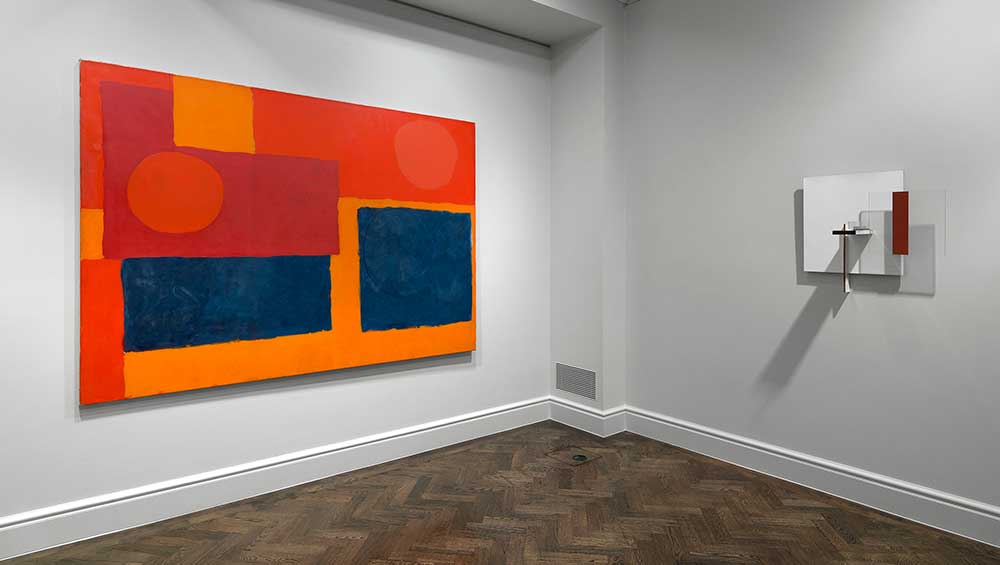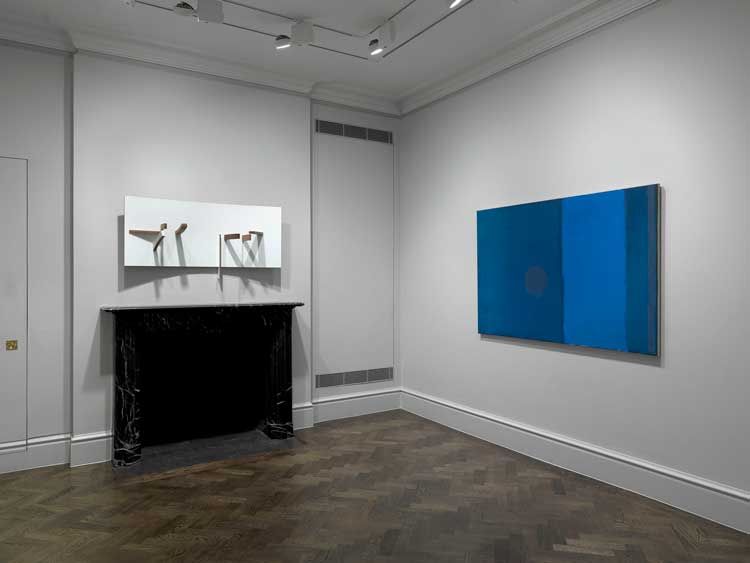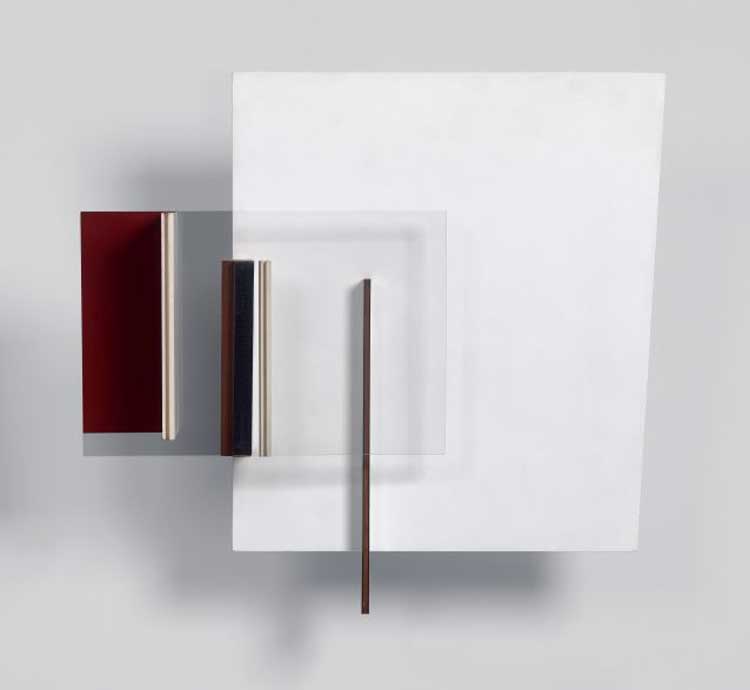
Installation view, Victor Pasmore | Patrick Heron: VIII São Paulo Biennial, Great Britain 1965, revisited, Hazlitt Holland-Hibbert, London. Courtesy Hazlitt Holland-Hibbert, London, copyright © the artist.
Hazlitt Holland-Hibbert, London
7 November 2024 – 31 January 2025
by TOM DENMAN
In many, perhaps not-so-obvious respects, Victor Pasmore and Patrick Heron would have made quite a team representing Great Britain at the eighth São Paulo Biennial in 1965. The older and more established Pasmore was one of Britain’s most prized artists, having earned a gig at the British Pavilion at the Venice Biennale in 1960 and a retrospective at the Tate Gallery the same year as the presentation in São Paulo. Twelve years Pasmore’s junior, Heron was a vociferous critic, a major promoter of British art, and the only artist participating in the biennial to do a Brazilian lecture tour – which immediately preceded his polemic, in the newly resurrected and rebranded Studio International, against what he called the “cultural imperialism” of American abstraction and “the obsequiousness to the Americans which prevails amongst so many British critics and art pundits generally”.1 The São Paulo Biennial, “the most important international exhibition of the plastic arts on the western side of the Atlantic” – as this magazine’s then editor GS Whittet put it – was to be leveraged as a chance for British non-representational art to assert itself.2

Installation view, Victor Pasmore | Patrick Heron: VIII São Paulo Biennial, Great Britain 1965, revisited, Hazlitt Holland-Hibbert, London. Courtesy Hazlitt Holland-Hibbert, London, copyright © the artist.
An approximate and abridged restaging of the São Paulo exhibition timed to coincide with its 60th anniversary, the show at Hazlitt Howard-Hibbert (in collaboration with Frankie Rossi Art Projects) manifests a sort of time warp, a feeling that deepens as I review it in these pages. Included are several works known to have travelled to South America and others that fit the period; the lack of any known photographic record of the original has necessitated a degree of curatorial detective work, again reminding us of a different, pre-digital era. Now, as in 1965, the show harnesses the international premise of São Paulo, except this time its invocation – bearing in mind the ascendency of the biennial as an exhibiting body and the global south as an on-trend geographic theme – might be interpreted as an attempt to rescue the two artists from old-fogeyism. As crucial as they may be in the history of British modern art, Pasmore and Heron today may be seen – albeit narrow-mindedly – to represent a deeply unfashionable, socially exclusive aesthetic of “English” restraint; or as the curator Ronald Alley put it in the catalogue to Pasmore’s Tate retrospective, “extreme refinement of taste”.3 The challenge for anyone visiting this show is to avoid these connotations becoming intrusive – an issue which, at their best, the works do the job of alleviating.
.jpg)
Victor Pasmore, Abstract in White, Black and Maroon, 1962. Curved relief construction with painted wood, 24 x 48 x 8 ½ in (61 x 122 x 21.5 cm). Courtesy Hazlitt Holland-Hibbert, London, copyright © the artist.
Though the wall text tells us that “the aesthetic differences between Heron and Pasmore’s work are stark”, this view seems in stronger accordance with perceptions of the time they were first shown together – Whittet, for instance, contrasted Heron’s “musical strength” with Pasmore’s “unadulterated and choice art”. What is perhaps most interesting about the restaging is how the inverted telescope of 60 years has softened the disparity, even accentuating the balletic counterpoint between the artists. On surface, the artists are markedly different. In the years leading up to the biennial, Pasmore had been experimenting with physical three-dimensionality, creating architectonic reliefs of overlapping materials – paint, wood, Perspex, Formica – with a tersely serious chromatic spectrum mostly consisting of browns, blacks and whites; whereas Heron’s paintings were more loyal to the medium, exploring its potential to create visually engrossing harmonies with vital colour contrasts and loose-edged circles and rectangles.

Victor Pasmore, Abstract in White, Black and Indian Red, 1963-64. Relief construction with painted wood and Perspex, 22 1/2 x 23 1/2 x 7 in (57.5 x 59.5 x 17 cm) including wood extrusions. Courtesy Hazlitt Holland-Hibbert, London, copyright © the artist.
And yet both artists aimed at a lyrical, intuitive harmony fusing the abstract with the natural. The artifice of Pasmore’s materials, especially the plastics, and their hard, quasi-industrial edges are counterposed by the organic rhythms of his compositions, not to mention the jauntily analogue quality of the way he puts his constructions together, which our technologically advanced perspective no doubt amplifies. His Abstract in White, Black and Indian Red (1963-64) consists of a white board and two booklike wooden brackets suspended before it by a sheet of Perspex, the wooden forms flourishing – like a bird in motion – beyond the white support to the left, while the board’s slanted right edge creates an additional centrifugal thrust along the opposite diagonal. When Pasmore doesn’t fly, he at least fascinates. Abstract in Black, White and Mahogany (1965-66) is an awkward balance of overthinking and floating. We can imagine his cogitation as he affixes to a black board a configuration of wooden knobs and plastic bars, suspending in them a square sheet of transparent plastic – and perhaps frustration when he finds that the sheet is imperfectly aligned with the board. Both the dancing and the grappling suggest our own naturalisation of their components in the things among which we live.
.jpg)
Patrick Heron, Big Red Horizontal with Ultramarine: 1964, 1964. Oil on canvas, 60 x 84 in (152.4 x 213.4 cm). Courtesy Hazlitt Holland-Hibbert, London, copyright © the artist.
Time and again in his writing, Heron would differentiate painting from sculpture by emphasising the former’s use of colour as an illusory, rather than actual, means of creating pictorial space, and in the works he made for the biennial, he fine-tuned this chromatic approach. In the intimate space of the gallery, the murmurous swathes and subtle colour switches in Big Red Horizontal with Ultramarine: 1964 (1964) are spellbinding: blue rectangles appear to protrude while their oceanic hue sucks you in; a dusky circle in the top right seems to be set back from the warmer orange surrounding it, while another circle, on the left of the canvas, in a richer hue – as if suggesting physical thickness – seems to stick out, the signalling between two points echoing the oft-heard observation that Heron’s works are musical. Perhaps the most effective way in which Heron’s colour fills the room is the way it envelops you.
-(2).jpg)
Patrick Heron, Vertical Blues with Disc: December 1962, 1962. Oil on canvas, 40 x 60 in (101.6 x 152.4 cm. Courtesy Hazlitt Holland-Hibbert, London, copyright © the artist.
Heron’s colour may have countered Pasmore’s relief, but the artists were like two sides of the same coin – and in this there was considerable overlap. Contrary to what he proselytised in his writing, Heron did not use colour alone. Some colours are drier, rougher and more visibly brushed than the ones they neighbour, as in some of the blue circles in Clear Blues in Green and White, August 1962 (1962). “Colour is both the subject and the means; the form and the content; the image and the meaning, in my paintings today,” Heron intoned in 1963, but his use of texture is more depictive than this oft-quoted line implies.4 The dark, curtain-like, frayed-edged swathes of dark blue in Vertical Blues with Disc: December 1962 (1962) resemble raw silk. While Heron pushed the limits of non-representational illusory space, Pasmore tested these same limits from the angle of physical actuality, with muted colours compensating for the inversion. He approaches Heron in his Brown Development No 3 (1964), which appears physically flat – as a painting on canvas – until closer inspection reveals layers of wood and plastic. The work is the show’s Venn-diagrammatic intersection.
It is hard to judge whether Britain’s participation at the eighth São Paulo Biennial succeeded. The following iteration, in 1967, for the British and the Americans at least, became a celebration of pop art. Perhaps more telling is the fact that, today, American names spring to most people’s minds when thinking about postwar abstraction, and in the British context, the figurative painters David Hockney, Lucian Freud and Frank Auerbach hold more non-specialist currency. Intentionally or otherwise, the redo sets the stage for a kind of art history lesson, about how art changes with time – we are left to imagine how it might change with place – along with how we respond to it.
References
1. The ascendancy of London in the sixties by Patrick Heron, Studio International, December 1966, page 280; A kind of cultural imperialism?, Studio International, February 1968, page 62.
2. The Dynamic of Brazil: The VIII Bienal of São Paulo by GS Whittet, Studio International, October 1965, page 136.
3. Introduction by Ronald Alley. In: Victor Pasmore: Retrospective Exhibition 1925-65, Tate Gallery, 1965, page 5.
4. A Note on my Painting: 1962 by Patrick Heron. Cited in: Painter as Critic, Patrick Heron: Selected Writings, edited by Mel Gooding, published by Tate Publishing, 1998, page 154.